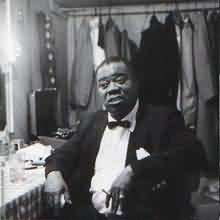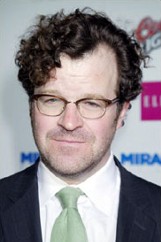Pops: A Life of Louis Armstrong will be officially “published” on Wednesday. That’s a formality, of course: it’s been available from online booksellers for a month and started showing up in bookstores three weeks ago. Over the long holiday weekend, Pops appeared on Michiko Kakutani’s top-10 list in the New York Times and was prominently featured in the the Cleveland Plain Dealer, the Kansas City Star, the Los Angeles Times, and my own paper, The Wall Street Journal. For the past week, it’s been Amazon’s top-selling jazz book.
All this good news notwithstanding, December 2 is still a big day for me, not least because that’s when my coast-to-coast book tour gets going. I leave for Boston in the afternoon after making two radio appearances, and on Thursday night I’ll be speaking at the Boston Athenaeum. After that I’ll be in and out of New York City through December 18, when I wrap up my tour in New Orleans and head home to Smalltown, U.S.A., for the holidays.
 In case you didn’t see it in this space the other day, here’s a complete and updated list of the personal appearances I’ll be making in December. Come out and see me!
In case you didn’t see it in this space the other day, here’s a complete and updated list of the personal appearances I’ll be making in December. Come out and see me!
* * *
• BOSTON, DECEMBER 3: Boston Athenaeum, 10½ Beacon St., 6 p.m.
• NEW YORK, DECEMBER 7: Barnes & Noble Lincoln Triangle, 1972 Broadway, 7:30 p.m.
• LOS ANGELES, DECEMBER 8: Los Angeles Public Library, 630 W. Fifth St., 7 p.m.
• BALTIMORE, DECEMBER 9: Enoch Pratt Free Library, 400 Cathedral St., 6:30 p.m.
• PHILADELPHIA, DECEMBER 10: Philadelphia Free Library, 1901 Vine St., 7:30 p.m.
• CHICAGO, DECEMBER 15: Highland Park Library, 494 Laurel St., 7 p.m. (note the time change)
• ST. LOUIS, DECEMBER 16: Maryville University (with Left Bank Books), Buder Commons, 650 Maryville University Drive, 7 p.m. (note the address change)
• NEW ORLEANS, DECEMBER 17: Garden District Bookshop, 2727 Prytania St., 5:30 p.m.
Archives for November 2009
TT: From the horse’s mouth
 Marc Myers, whose JazzWax has become one of the most widely read and influential jazz sites on the Web, interviewed me about Pops earlier this month. This week he’s posting a five-installment series devoted to that interview.
Marc Myers, whose JazzWax has become one of the most widely read and influential jazz sites on the Web, interviewed me about Pops earlier this month. This week he’s posting a five-installment series devoted to that interview.
Here’s part of today’s installment:
JW What did Armstrong understand about simplicity that was lost on so many other musicians?
TT Simplicity is absolutely central to Louis’ development as an artist. Louis started out as a young virtuoso who was in love with the sound of his own horn. When you can play anything you hear, you want to hear yourself play. Louis apprenticed with King Oliver, who ingrained in him the centrality of melody to the jazz musician. Armstrong’s exposure to Oliver and his view of melody made him feel that it was not only appropriate to embrace simplicity but also vital to appeal to audiences in an immediate way.
JW But Oliver was certainly less technically gifted than Armstrong.
TT That’s true. Yet it’s Oliver who made Armstrong believe it was far better to be simple than complicated. Armstrong internalized these lessons at age 21, and he lived by them throughout his career….
To read the whole thing, go here.
TT: A week of Satchmo snapshots (1)
To celebrate the publication this week of Pops: A Life of Louis Armstrong, I’ll be posting Armstrong videos every day.
In today’s video, an excerpt from a 1958 Timex All Star Show telecast, Armstrong, Ruby Braff, and Jack Teagarden perform “Jeepers Creepers,” originally recorded by Armstrong in 1939:
TT: Almanac
“Ain’t nobody played nothing like it since, and can’t nobody play nothing like it now. My oldest record, can’t nobody touch it. And if they say, ‘Which record do you like the best?’ I like them all, because I didn’t hit no bad notes on any of them.”
Louis Armstrong (quoted in Terry Teachout, Pops: A Life of Louis Armstrong)
TT: Scenes from a marriage (cont’d)
Scott Martelle, who profiled me earlier this year in Publishers Weekly, has now written a Pops-related interview that will appear in Sunday’s Los Angeles Times. It’s crammed full of good quotes, and it also contains a description of me that is causing a fair amount of mirth in my household:
Teachout…is a heavyset man with a wide, expressive smile and glasses that make him look owlish. He speaks in long, discursive paragraphs, his diction precise, his tone a bit arch and bearing no hint of Missouri, where he grew up in a small town.
HE Do I really sound arch when I talk?
An excruciatingly long pause
SHE Welllllllll…
* * *
Read the whole thing here.
TT: When artists dry up
 As I noted in my review of The Starry Messenger, Kenneth Lonergan went eight years between plays, and many of his admirers, myself among them, had long since started to fear that he was falling victim to the same curse of sterility that previously struck down such artists as Ralph Ellison and Aaron Copland, both of whom fell silent at the peak of their careers and subsequently found it impossible to create new works.
As I noted in my review of The Starry Messenger, Kenneth Lonergan went eight years between plays, and many of his admirers, myself among them, had long since started to fear that he was falling victim to the same curse of sterility that previously struck down such artists as Ralph Ellison and Aaron Copland, both of whom fell silent at the peak of their careers and subsequently found it impossible to create new works.
What causes gifted artists to dry up unexpectedly–and are there artists who should dry up? That’s the subject of my “Sightings” column in Saturday’s Wall Street Journal. If the subject interests you, pick up a copy of tomorrow’s paper and see what I have to say.
UPDATE: Read the whole thing here.
TT: Almanac
“Whoever in discussion adduces authority uses not intellect but rather memory.”
Leonardo da Vinci, The Notebooks of Leonardo da Vinci (trans. Edward MacCurdy)
TT: Lost in the stars
I review two shows in Friday’s Wall Street Journal, Kenneth Lonergan’s The Starry Messenger and the Broadway transfer of Fela! The first is extraordinary, the second very good. Because of the Thanksgiving holiday, the Journal decided to post my Friday column on the paper’s Web site in advance of its appearance in print, so here’s an excerpt.
* * *
Eight years ago, Kenneth Lonergan was an artist of seemingly infinite promise, a writer with three plays and a movie under his belt, all of them memorable. Then Hollywood knocked him off the tracks, and of late his career has been looking more like a cautionary tale. “Margaret,” Mr. Lonergan’s second film, was shot in 2006 but is still stuck in post-production–he was reportedly unable to complete a final cut. Meanwhile, the premiere of his fourth play, “The Starry Messenger,” was announced twice and cancelled twice in the past four seasons, first by San Diego’s Old Globe Theatre and then by the Off-Broadway New Group.
 Now “The Starry Messenger” has opened Off Broadway, preceded by a string of alarming reports suggesting that Mr. Lonergan and his cast had a rocky time in rehearsal. No doubt they did, but you wouldn’t know it from seeing the finished product. Like “You Can Count on Me,” the 2000 film that first brought its author-director to the attention of a national audience, “The Starry Messenger” is an engrossing study of the toll that prolonged disappointment exacts on the human spirit, performed with consummate skill by an ensemble cast led by Matthew Broderick and staged with unassuming finesse by Mr. Lonergan himself.
Now “The Starry Messenger” has opened Off Broadway, preceded by a string of alarming reports suggesting that Mr. Lonergan and his cast had a rocky time in rehearsal. No doubt they did, but you wouldn’t know it from seeing the finished product. Like “You Can Count on Me,” the 2000 film that first brought its author-director to the attention of a national audience, “The Starry Messenger” is an engrossing study of the toll that prolonged disappointment exacts on the human spirit, performed with consummate skill by an ensemble cast led by Matthew Broderick and staged with unassuming finesse by Mr. Lonergan himself.
Mr. Broderick plays Mark, a 46-year-old astronomy teacher who dreamed as a young man of “becoming a real astronomer–a practicing astronomer,” then came to the reluctant conclusion that he wasn’t good enough to make the cut. Trapped in the smothering dailiness of family life and an unsatisfying job, he stumbles headlong into an affair with Angela (Catalina Sandino Moreno), a 28-year-old Puerto Rican nurse with a young child whose father refuses to marry her. Anne (J. Smith-Cameron), Mark’s wife, knows nothing of the affair but is all too aware of the reasons for his unhappiness: “You decided that everybody you were working with was more talented than you…You told me that. And I never forgot it. It was the most terrible thing I ever heard anybody say about themselves.”…
Is it really possible to write an interesting play about yet another frustrated family man of a certain age who seeks to plug the hole in his soul by having an affair with a younger woman? That’s like asking whether it’s possible to write yet another interesting symphony in the key of E minor. It says much about the nature of Mr. Lonergan’s gifts that for all the seeming obviousness of the plot of “The Starry Messenger,” you’ll never be able to guess what happens next. He is a theatrical alchemist who transforms the commonplace by portraying it with quiet honesty and charging it with moral complexity….
The designers of the Broadway transfer of “Fela!” have turned the staid interior of the Eugene O’Neill Theatre into a riotous facsimile of a corrugated-iron Nigerian dance hall that appears to have been jointly decorated by Romare Bearden and Paul Klee. The music played inside, a savory stew of big-band jazz, James Brown-style funk and African percussion known to its devotees as “Afrobeat,” is an ideal backdrop for the flat-footed, hip-swiveling dancing of the hottest chorus in town. All that’s missing from this bio-musical about the life of Fela Anikulapo-Kuti, the Nigerian pop star and political activist, is a plot, and an act and a half goes by before its absence becomes obtrusive….
* * *
Read the whole thing here.
